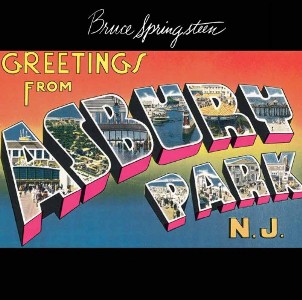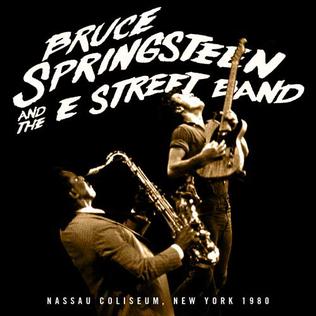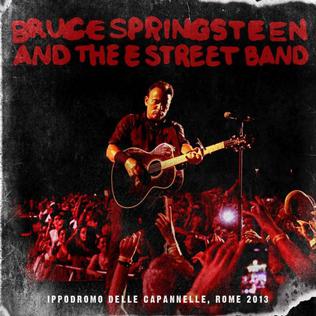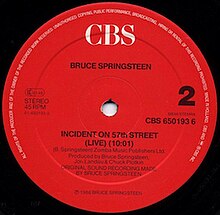
Greetings from Asbury Park, N.J. is the debut studio album by American singer-songwriter Bruce Springsteen. It was produced by Mike Appel and Jim Cretecos from June through October 1972 at the budget-priced 914 Sound Studios. The album was released January 5, 1973, by Columbia Records to average sales but positive critical reviews.

The Wild, the Innocent & the E Street Shuffle is the second studio album by American rock singer-songwriter Bruce Springsteen. It was recorded by Springsteen with the E Street Band at 914 Sound Studios, Blauvelt, New York, and released on November 5, 1973 by Columbia Records. It includes the song "Rosalita ", the band's most-used set-closing song through 1985.

"Rosalita " is a 1973 song by Bruce Springsteen, from his The Wild, the Innocent & the E Street Shuffle album, and is especially famed as a concert number for Springsteen and The E Street Band. The song, which clocks in at just over seven minutes, is a story of forbidden love between the singer and the titular Rosalita, whose parents disapprove of his life in a rock and roll band. It is included on the compilation albums The Essential Bruce Springsteen and Bruce Springsteen & The E Street Band Greatest Hits. In 2021, Rolling Stone ranked it the 446th greatest song of all time on their updated 500 Greatest Songs of All Time list.

The E Street Band is an American rock band, and has been musician Bruce Springsteen's primary backing band since 1972. The band was inducted into the Rock and Roll Hall of Fame in 2014. For the bulk of Springsteen's recording and performing career, the band consisted of: guitarists Steven Van Zandt, Nils Lofgren, and Patti Scialfa, keyboardists Danny Federici and Roy Bittan, bassist Garry Tallent, drummer Max Weinberg, and saxophonist Clarence Clemons.
David Sancious is an American musician. He was an early member of Bruce Springsteen's backing group, the E Street Band, and contributed to the first three Springsteen albums, and again on Human Touch (1992), Tracks (1998), and Western Stars (2019). Sancious is a multi-instrumentalist but is best known as a keyboard player and guitarist. He left the E Street Band in 1974 to form his own band, Tone, and released several albums. He subsequently became a popular session and touring musician, most notably for Stanley Clarke, Narada Michael Walden, Zucchero Fornaciari, Eric Clapton, Peter Gabriel, Jack Bruce, and Sting among many others. In 2014, Sancious was inducted into the Rock and Roll Hall of Fame as a member of the E Street Band.
"Jungleland" is the closing song on Bruce Springsteen's 1975 album Born to Run. It contains one of E Street Band saxophonist Clarence Clemons' most recognizable solos. It also features short-time E Streeter Suki Lahav, who performs the delicate 23-note violin introduction to the song, accompanied by Roy Bittan on piano in the opening.

The Rising Tour was a lengthy, worldwide, top-grossing concert tour featuring Bruce Springsteen and the E Street Band that took place in arenas and stadiums over 2002 and 2003. It followed the release of their 2002 album The Rising.
"She's the One" is a song by Bruce Springsteen. Frequently featured in Springsteen and E Street Band concert performances, it first appeared on the Born to Run album in 1975. It was also released as the B-side to Springsteen's "Tenth Avenue Freeze-Out" single.
"Racing in the Street" is a song by Bruce Springsteen from his 1978 album Darkness on the Edge of Town. In the original vinyl format, it was the last song of side one of the album. The song has been called Springsteen's best song by several commentators, including the authors of The New Rolling Stone Album Guide.

Bruce Springsteen & The E Street Band Greatest Hits is Bruce Springsteen's fifth compilation album, released as a limited edition first in the United States, Canada and Australia on January 13, 2009, exclusively through Wal-Mart retailers.

London Calling: Live in Hyde Park is a concert video of Bruce Springsteen & the E Street Band's performance during the Hard Rock Calling music festival in Hyde Park, London on June 28, 2009. The film was released on DVD and Blu-ray formats by Columbia Records on June 22, 2010.

"Point Blank" is a song written by Bruce Springsteen and first released on Springsteen's 1980 album The River. In Europe, it was also released as a single in 1981, backed by another song from The River, "Ramrod". Although it was not released as a single in the US, it did reach #20 on the Billboard Mainstream Rock Tracks chart.

Live Collection is the name of a Japanese 1987 four song live Bruce Springsteen EP. The EP features two tracks that did not make it into the Live/1975-85 collection: "For You" and "Incident on 57th Street". The River Tour performance of "Incident on 57th Street" released on this EP was the song's last outing until their 1999 reunion tour and has helped make this song a live favorite. The original LP included a fold-out color poster, and lyric sheet with the lyrics to all four tracks in English, and Japanese. The album has since been re-released starting in 2001 on compact disc.

The Agora, Cleveland 1978 is a live album by Bruce Springsteen & the E Street Band, released in December 2014 and was the second official release through the Bruce Springsteen Archives. The concert is available on CD-R and digital download at http://live.brucespringsteen.net.

Nassau Coliseum, New York 1980 is a live album by Bruce Springsteen and the E Street Band, released in March 2015, and was the fourth official release through the Bruce Springsteen Archives. The show was originally recorded live at the Nassau Coliseum in Uniondale, New York, on December 31, 1980.

Brendan Byrne Arena, New Jersey 1984 is a live album by Bruce Springsteen & the E Street Band, released in May 2015 and was the fifth official release through the Bruce Springsteen Archives. The show was originally recorded live at the Brendan Byrne Arena in East Rutherford, New Jersey on August 5, 1984.

Ippodromo Delle Capannelle, Rome 2013 is a live album by Bruce Springsteen and the E Street Band, released in November 2015 and the eighth official release through the Bruce Springsteen Archives. The show was originally recorded live at the Ippodromo delle Capannelle in Rome, Italy on July 11, 2013 during the Wrecking Ball Tour.

Palace Theatre, Albany 1977 is a live album by Bruce Springsteen and the E Street Band, released in August 2017. It is the fifteenth such release by the Bruce Springsteen Archives. The show was recorded on February 7, 1977 at the Palace Theatre in Albany, NY and is the first-ever soundboard recording to surface from the 1977 tour which features early renditions of “Something In The Night,” “Rendezvous” and “The Promise” along with the unreleased original “Action In The Streets” featuring the Miami Horns.

Auditorium Theatre, Rochester, NY 1977 is a live album by Bruce Springsteen and the E Street Band, released in August 2017. It is the sixteenth such release by the Bruce Springsteen Archives. The show was recorded on February 8, 1977 at the Auditorium Theatre in Rochester, NY and is one of the first soundboard recordings to surface from the 1977 tour which features early renditions of "Something in the Night", "Rendezvous" and "The Promise" along with the unreleased original "Action in the Streets" featuring the Miami Horns.

The Summit, Houston, TX December 8, 1978 is a live album by Bruce Springsteen and the E Street Band, released in September 2017, and is the eighteenth official release through the Bruce Springsteen Archives. The show was recorded on December 8, 1978 at The Summit in Houston, TX during the Darkness on the Edge of Town Tour.
















